Introduction to Animal Kingdom
The animal kingdom is an amazing tapestry of life forms ranging from microscopic organisms to colossal giants that swim in the oceans, roam the land and soar through the skies. To comprehend this vast assortment of animals, scientists have devised a system called classification. It is a process of organizing and categorizing living organisms based on their unique characteristics.
The basis of classification in the animal kingdom depends upon several key factors. These factors include habitat, cellular organization, and body structure, to name only a few. By carefully analyzing these aspects, scientists have grouped animals into different categories, or taxa based on their similarities and differences.
So, let’s embark on this captivating journey into the classification of the animal kingdom, where we will unravel the mysteries of the animal world, discover hidden connections between species, and marvel at the sheer diversity of life that surrounds us.
1. Habits and Habitats
- Habitat: The place where organisms live. There are broadly two types of habitat i.e., aquatic and terrestrial. The former lives in water and the latter one lives on land. However, we can further divide habitat into their sub categories.
A. Aquatic habitat
- Marine water (sea water with high salt content)
- Fresh water (river water with very less quantity of salt compared to sea)
- Brackish water (this is the place where river opens into the sea i.e, the junction where river water and sea water meets. Here the salt concentration fluctuates at certain areas — some areas will have high salt concentration, some will have low salt and at certain areas, only low salt concentration would be present)
Different Organisms Living in the aquatic environment
Zooplankton: These are passively floating or drifting animals on the surface of water as they cannot swim by themselves. They flow as per the directio of the water current. Example – jelly fish, daphnia (water fleas), etc.
Nekton: These are actively swimming organisms in water. Example: Shark, bony fish, etc
Neuston: These are minute organisms that rests on the surface of water and flow as per the direction of the water current. Example: mosquito larva
Benthic: These are organisms that reside at the bottom of the water bodies. It means, these organisms are present at the bottom of sea, river where there is no light present. Example: mussels, sea stars, sea urchins, crabs, etc.
Lentic: These are organisms living in stagnant water body. They are mostly present in lakes, pond,and wetland etc. Example: dragonflies, turtles, amphibians such as frogs, toads, salamander
Lotic: These are organisms living in running water bodies such as sea. Example: mayflies, crayfish, etc.
B. Terrestrial Habitat
- Cursorial: fast runners — example: horse, lion, dog, cockroach
- Fossorial: live in burrows — example: mice, snake, earthworm
- Arboreal: live on trees — example: monkey
- Scansorial: climb walls — example: lizard
- Volent / aerial: flying — example: birds
Habits:
A. Solitary: live alone – -example: tapeworm
B. Colonial: form an organized colonies and help each other — example: honeybee
C. Gregarious: lives in large groups but do not help each other — example: locust
D. Free living: lead independent life — example: horse
E. Sessile/sedentary: permanently attached to substratum — example: sponges
F. Sanguivores: blood feeders — example: leech, female anopheles
G. Cannibals: consume their own species — example: cockroach
2. Level of Organization
Cellular level of organization: Organisms are multicellular, but they are not organized to form tissue, and therefore, each cell is independent of the other cell and that is the reason why such organisms are kept under cellular level. Example: Sponges (phylum: Porifera)
Tissue level of organization: cells cluster together and function as a group, meaning, forms a tissue to perform work. Example: Coelentrata, Ctenophora
Organ level of organization: Tissues arrange together and form organ. The first such organ was for digestion. Example: Platyhelminthes
Organ system level of organization: Organs together for the organ system to perform specific functions within an organism. For instance, in respiratory system, lungs, trachea and bronchi facilitate the exchange of oxygen and carbon dioxide between the body and the external enviornment. Example: starting from the Phylum Aschelminthes to chordata
3. Body Plan
The term body plan refers to the overall organization and arrangement of the major structures and systems within an organism’s body. It encompasses the fundamental features and patterns that define the body’s shape, symmetry, segmentation, and arrangement of its organs and appendages.
l. Cell aggregate body plan:
It refers to a type of organization found in some simple multicellular organisms such as sponges where cells form a non-integrated mass without a defned tissue differentiation or specialized organs. In this body plan, cells maintain their independence and peform their functions individually or in loose coordination with neighboring cells. Example: Sponges (Phylum — Porifera)
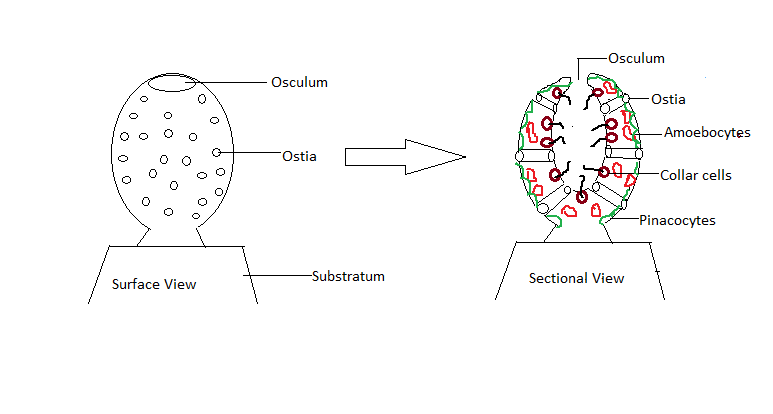
II. Blind sac body plan:
It refers to the body organization where the digestive system forms a single opening that functions as both the mouth and anus. Organisms possess a sac-like structure with only one opening through which food enters and waste is expelled.
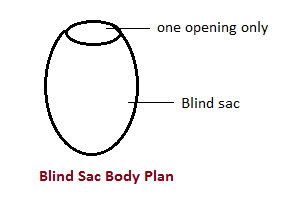
Examples: Cnidaria, platyhelminthes
Note: Gut (alimentary canal) can be of two types: incomplete and complete. In the former case, only one opening is present for influx and efflux of things. On the other hand, the complete alimentary canal consists of two openings i.e., mouth and anus or cloaca
III. Tube within Tube:
It refers to the body organization where the digestive system is composed of two interconnected tubes — the outer tube i.e., the body wall or body cavity and the inner tube i.e., the digestive tract.
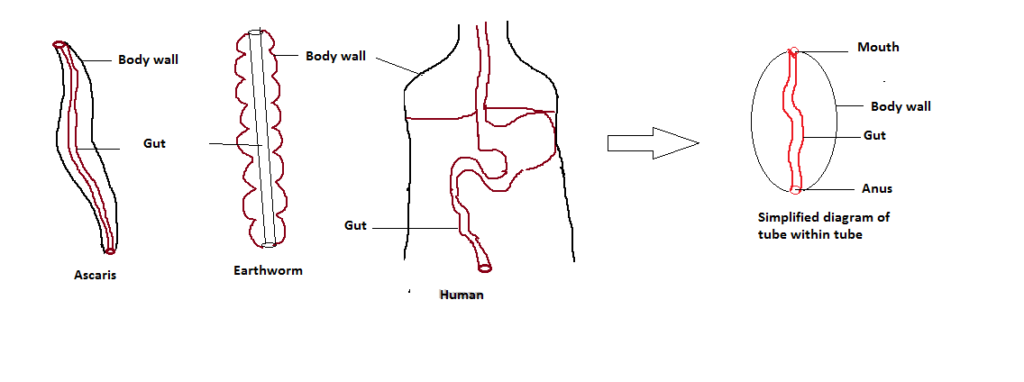
Examples: Aschelminthes to Chordates
Note: The digestive tract has two openings i.e., mouth and anus. The question is which forms first –mouth or anus? Based on the formation of mouth and anus, organisms can be divided into two types:
PROTOSTOMIC (PROTO – First; STOMIC – Mouth) — Example: Platyhelminthes, Aschelminthes to Mollusk
DEUTEROSTOMIC (DEUTERO – Second; STOMIC – Mouth) — Example: Echinodermata to Chordata
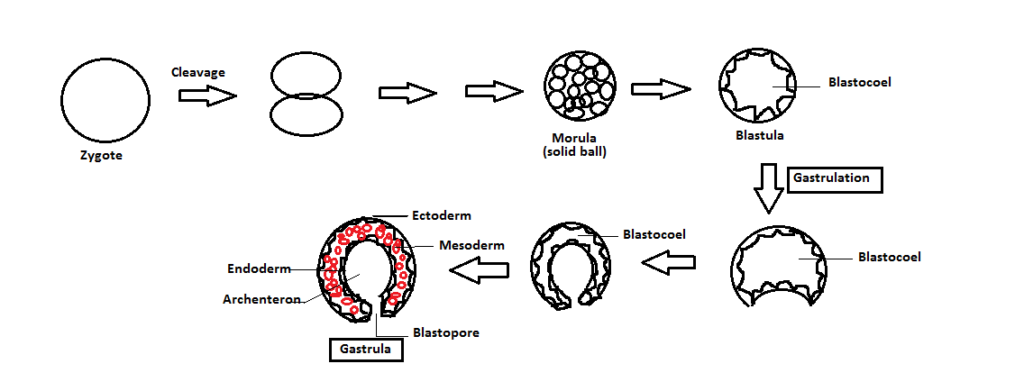
zygote starts cleavage to form 2, 4, 8, and 16 cells. the 16 celled solid ball is called MORULA. In the next stage, the cells of morula depart and form a central cavity. This structure is called BLASTULA and the cavity itself is called BLASTOCOEL. From blastula, gastrulation (formation of germ layers) process starts.
To understand the process of gastrulation, let’s take the analogy of a football with a little air in it. Press the ball at the bottom upward. This football is the blastula and when it is pressed at the bottom upward, the lower portion of the blastula moves up as shown in the picture. The upward movement of the basal layer continues until it reaches the upper surface of the blastula. However, the blastocoel is still present in the embryo. In the final stage, the blastocoel is completely obliterated and this space is occupied by a mass of cells and forms the final structure, called GASTRULA where three germ layers can be seen i.e.e, the ectoderm, mesoderm and the endoderm. In diploblastic animals, only two germ layers are seen i.e., ectoderm and endoderm.
At gastrula stage, though the blastocol is obliterated, a new cavity is formed, called archenteron and the opening of the archenteron is called BLASTOPORE.
Summary:
Changes during blastula to gastrula formation (gastrulation) involves several changes, as mentioned below:
- Single layered embryo (blastula) converts into multilayered embryo (gastrula)
- 2-3 germ layers are formed
- blstocoel is obliterated by mesoderm
- A new cavity is formed, called archenteron; the opening of archenteron is called blastopore
In future, this archenteron would give rise to gut / alimentary canal / GIT, and as eveyone knows, the gut consists of two openings i.e., mouth and anus / cloaca. At this stage of the embryo, only ne opening i.e., blastopore is present, but once the embryo would develop into a complete organism, two openings would be seen in the GIT.
At embryonal stage, blastopore has two fates:
a. Blastopore in future would develop into mouth and the opposite end would form anus/cloaca. This is referred to as PROTOSTOME (PROTO = anterior; STOME = opening). PROTOSTOME type of embryo development occus in Platyhelminthes, Aschelminthes, Annelida, Arthropoda and Mollusc.
b. Blastopore in future would develop into anus/cloaca and the opposite end would form the mouth. This is reffered as DEUTEROSTOME (DEUTERO = posterior; STOME = opening). DEUTEROSTOME type of embryo development occurs in Echinodermata, Hemichordata, and Chordata.
4. Segmentation:
Segmentation in animals refers to the division of the body into repeated segments or compartments. These segments often have a similar structure and are arranged linearly along the body axis. Each segment may contain a set of organs, appendages, or specialized structure.
Types of Segmentation
a. Pseudometamerism / False Segmentation
In order to understand what is false segmentation, let’s take the example of a tapeworm and its development. When the lava (cysticercus) enters the human body after the consumption of contaminated pork (measley pork), it causes taeniasis. The cysticercus larva enters through mouth to the stomach and then to the intestine. The outer cyst gets dissolved and the larva comes out. After some time, it starts development and forms rostellum and sucker. Besides, budding also starts at the neck region. However, segmentation occurs at the anterior end of the body. In other words, the newest segment of the body would be present at the neck region. Example: Tapeworm (Phylum: Platyhelminthes)
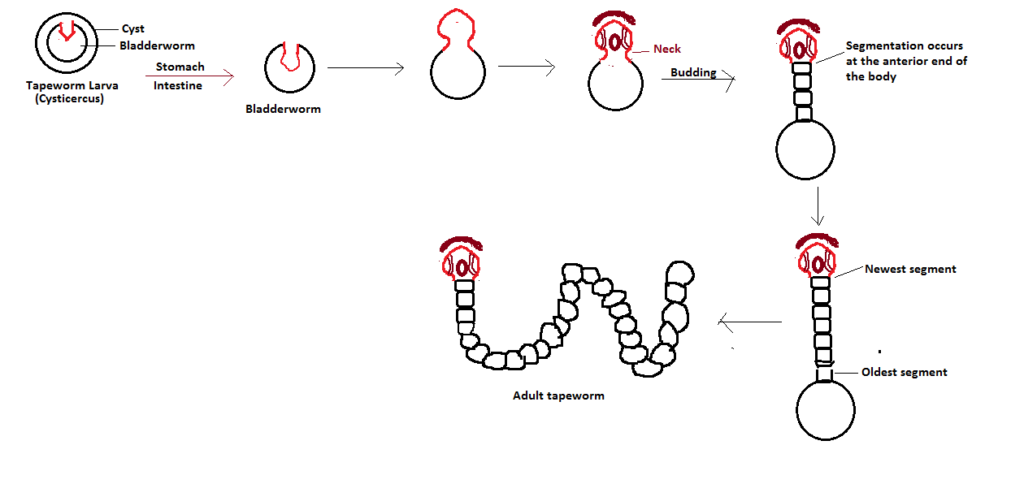
Two points needs to be considered while describing false segmentation. These points are mentioned as follows:
- New segments are added from the anterior end of the body.
- Segments of the body are not associated physiologically. It means, cutting any segments of the body will not have any effect on the body as each segment is independent of the other for survival.
b. Metamerism / True Segmentation

To understand this concept, let’s take the example of an earthworm. In earthworm, the last segment at the posterior end would be the newest one. And the segment present at the anterior end would be the oldest one. Example: Phylum: Annelida
Two points need to be considered for true segmentation
- All segments are physiologically associated with each other
- Post end segment would be the newest segment
- The external segment truly corresponds to the internal segment of the body
- Cutting any segment of the body would lead to death of the organism
Note: In case of arthropods, only external segmentation is present. However, in case of chordates, internal segments are present such as diaphragm, thoracic cavity, pelvic cavity, Segmental muscles of abdomen, vertebral columnm, etc.
5. Body Symmetry
It is defined as the geometrical positioning of different organs and structures in the body. If the geometrical positioning of structures on the left and right side of the body is present in such a way that one cannot divide the body in two equal halves then it is called asymmetrical body, examples: amoeba, sponges, snails, herdmania, etc. On the other hand, if the body can be divided into two equal halves then such an arrangement is called symmetrical.
Types of Symmetry
I Spherical (sphere = ball) symmetry
- Organisms are ball like.
- Cut the ball (body) in any direction, however, the cut plane should pass through the centre.
- Such spherical body does not have direction and therefore, depends on the flow of warer currents. That is why, nature evolved such organisms and made them cylindrical (radial) i.e., the second type of body symmetry.
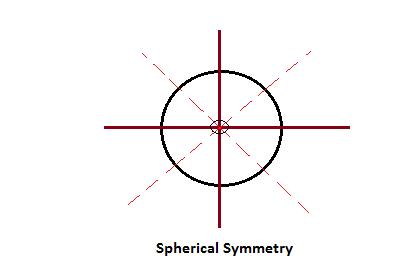
Examples: Volvox (Protozoa), Sea Urchins (Echinodermata), Sponges (Porifera)
II. Radial symmetry
- The basic structure of the organism is either cylindrical or umbrella shaped
- The body can be divided by any of the planes along the radius passing through the central axis.
- Polarity (oral and aboral end) developed in organisms with radial symmetry. The aboral end would get attached to the substratum and the oral end would cath food.
- Radial symmetry is beneficial for sessile animals

Example: Hydra (cnidaria)
ii-a. Biradial Symmetry
In this case, the body can be divided into two equal halves along two different planes.
Example: Sea anemone, ctenophora
Note: In starfish, pentamerous radial symmetry is present (Echinodermates)
III. Bilateral Symmetry
- Surfaces (dorsal, ventral and lateral) appear with this symmetry. The main advantage of the presence of surfaces is that vital organs of the body can be kept inside the surface that is least exposed. For instance, in humans, all vital organs such as lungs, heart, liver, etc are present inside the ventral surface and the dorsal surface is made stronger to protect them.
- Cephalization (evolutionary development of a distinct head region) is one of the characteristic features of bilateral symmetry. However, it is important to note that cepharlization started at platyhelminthes, but it became distinct at arthropoda. Cephalization enables unidirectional movement of an organism.
- The body of an organism can be divided into two equal halves when cut at mid sagital plane.
Example: Asheminthes, annelida, arthropoda, mollusca, hemichordata, chordata
6. Germ Layer:
Germ layers are nothing but the primary cell layers that form during the early stages of the embryonic development in animals. These germ layers include ectoderm, mesoderm and endoderm.
Nature started with only two germ layers i.e., diploblastic. This does not mean, diploblastic animals are flat, they do contain a non-living layer caled MESOGLEA.
Example: Porifera, Cbidaria, Ctenophora
Triploblastic organisms contain three germ layers i.e., ectoderm, mesoderm and endoderm.
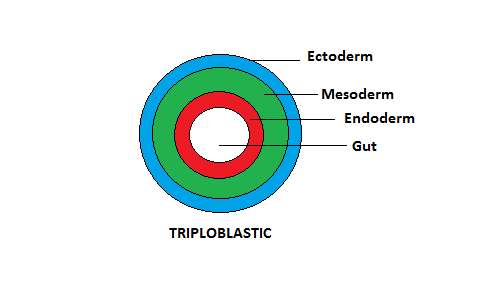
If you look at the above picture, all three layers are packed and there is no space left to jeep organs inside the body. Such organisms will look flat. To make the organisms swollen, a cavity must be there. In other words, one cannot fill air in the flat layer unless there is an air cavity present to get air. The cavity formed in the body is called true body cavity or COELOM.
Examples: Platyhelminthes to chordates
7. Coelom / Body cavity
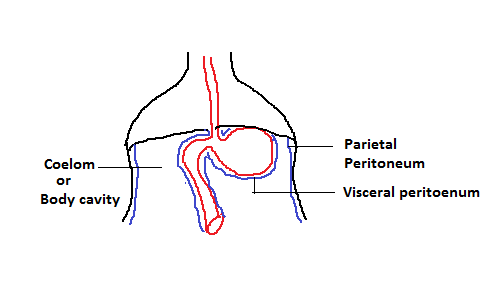
it is the space between body wall and the alimentary canal, which is lined on both sides by mesoderm. For example, in humans, the inner body wall is lined by parietal peritoneum and the alimentary canal is lined by viseral peritoneum. The space between parietal peritoneum and visceral peritoneum is called coelom. Here, the peritoneum has its origin as mesodermal.
Types of Body Cavity
Pseudocoelomate: When the body cavity is not covered by mesodermal layers on both sides, such body cavity is called pseudocoelomate. There could be two situations to form pseudocoelom:
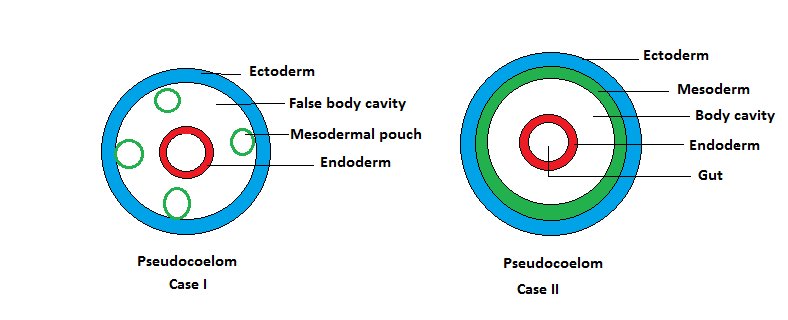
Case I: In some organisms, body cavity is not lined by mesoderm. Mesodermal pouches are found scattered between the ecotdermal and endodermal layer.
Case II: In some organisms, body cavity is formed in the mesoderm, but it is lined by mesoderm only on one side i.e., the outer side of the body cavity; the inner side of the body cavity is lined by endoderm.
Examples: Aschelminthes
Note: In true coelom, the body cavity is lined by mesodermal layer on both sides.
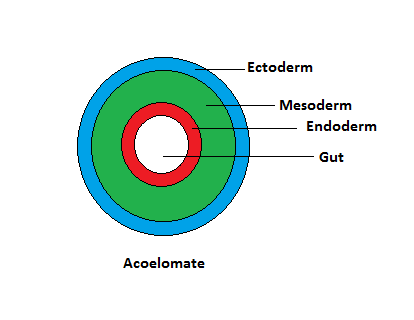
In some organisms, no body cavity is present. Such organisms are called acoelomate organisms. Example: Platyhelminthes
Eucoelomate: It is of two types: Schizocoelom and Enterocoelom
In schizocoelomic planning, the germpore forms mouth and the opposite end forms the anus. However, in enterocoelomic planning, germpore forms the anus first and the opposite end would form the mouth.
Annelida —> Mollusca — Protostomia = Schizocoelomic planning
Echinodermata — > chordata — > Deuterostomia = ENterocoelomic planning

